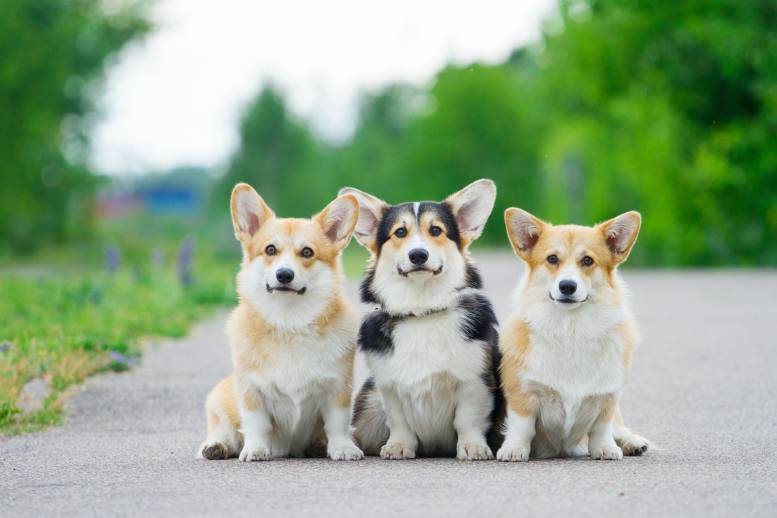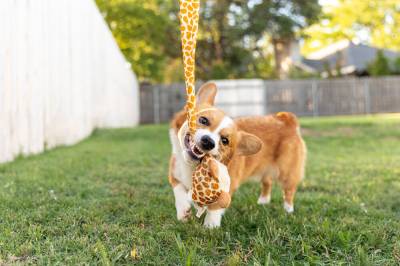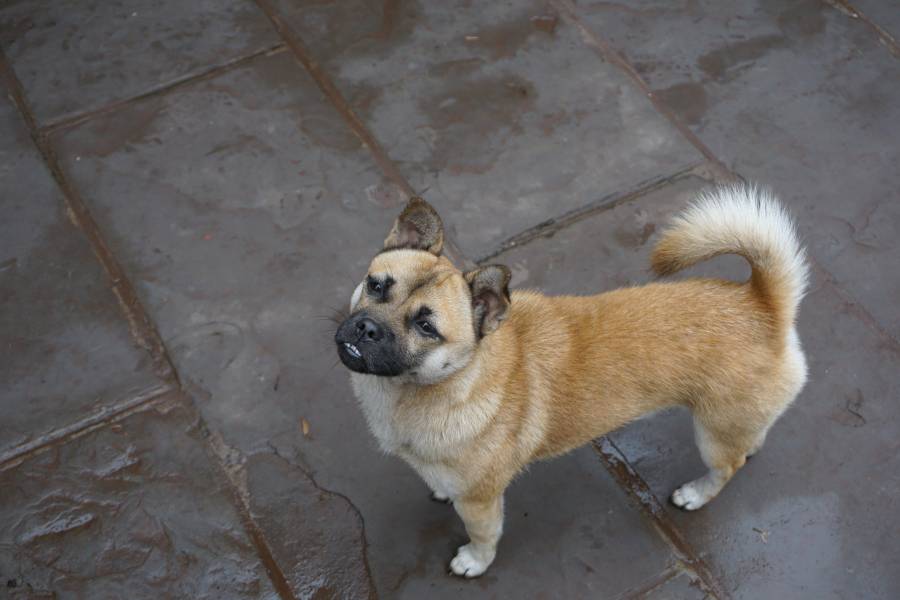Connect with a verified veterinarian in minutes. Licensed vets are available 24/7 to answer your questions. No need to worry about your furry family member.
Corgis are one of the most popular dog breeds in the world! And there’s a good reason for that! There are two different types of Corgis we’ll discuss. We’ll also talk about the 13 recognized colors of Corgis. Let’s get started!
The Pembroke Welsh Corgi
The first type of Corgi we’ll take a look at is the Pembroke Welsh Corgi. The Pembroke Welsh Corgi seems to have originated in Belgium and were brought to Wales in 1107. They were used to herd sheep and cattle in those days.
They are sometimes confused with the Cardigan Corgi; however, the two dogs are easy to tell apart. Pembroke Welsh Corgis have a docked tail and usually have red, sable, fawn, or tri-colored coats. They may also have white markings on their legs, chest, belly, neck, and muzzle.
These small dogs are highly intelligent and were developed to be herding dogs. They still work today, doing the same job! It’s hard to believe these dogs can run on their short legs. But if you’ve ever seen these dogs in action, they can keep up very well with the cattle they’re herding!
Pembroke Welsh Corgis usually weigh up to 30 lbs and stand between 10 to 12 inches tall. These dogs tend to have a double coat, which works to keep the dog protected from all types of weather.
When it comes to health, Pembroke Welsh Corgis have a life span of about 12 years. However, they are subject to kidney problems, cancer, and other health conditions. They may also suffer from eye conditions, such as progressive retinal atrophy and glaucoma.
Pembroke Welsh Corgis have been the favorite of Queen Elizabeth II for years. Her first Corgi was given to her on her 18th birthday in 1944. Since that time, the Queen has bred these dogs for several generations.
The Cardigan Welsh Corgi
The Cardigan Welsh Corgi is the second breed of Corgi and is the older breed of Corgi. It’s thought the dogs first originated over 3,000 years ago in Wales. This makes Cardigan Corgis the older of the two breeds. They are thought to have been brought to Wales by the Celts from Central Europe around 1200 BC. The dogs were bred to protect the home and family, as well as herd cattle.
Just like their Pembroke cousins, Cardigan Corgis are also working dogs. They’ve long been used to herd cattle. However, they also love to be with their families and make great companions for older children.
You can tell the Cardigan from the Pembroke Cori by their coloring and their long tail. These dogs look as if they’re wearing a cardigan and come in various colors, including red, brindle, blue merle, and black. They usually have white markings, too. The Cardigan is also a little bit larger than the Pembroke. These dogs usually weigh between 30 to 38 lbs.
These dogs are also highly intelligent and affectionate. They’re also very vocal and tend to bark at just about everything. While very intelligent, they can be extremely stubborn. They also have a very strong herding instinct. Some dogs may even try to herd other pets, children, and even adults. The dogs may nip at the heels to get you going!

Review symptoms, medications & behavior to keep your pets healthy with a Vet Online in just minutes.
Ask a Vet Live NowAre Corgis Good for Families?
While they are working dogs, Corgis do make great family dogs! They are very affectionate and adaptable, which means they can adjust to almost any family and living arrangement. They do well in large or small homes, with or without a large backyard.
However, these dogs have a ton of energy! You’ve been warned! If you adopt a Corgi, expect to take long walks every day to ensure your fur baby gets all the exercise he needs. And don’t underestimate the speed of a Corgi. Their short legs can carry them pretty fast!
What are the Corgi Colors?
As you read above, there are two separate breeds of Corgis. Each breed, while similar, has slightly different characteristics, including color.
In this section, we’ll take a look at the different Corgi colors, starting with the Pembroke Welsh Corgi.
First, we’d like to explain some terms you’ll see in the color descriptions below.
- Sable: is a mixture of colors, usually red, brown, and black. These colors combine to create a unique coat.
- Brindle: this is a Corgi coat that has brown as the foundation color. This color has overlays of dark brown or black stripes, somewhat resembling a tiger’s coat.
- Merle: is a marbled coloring of the dog’s coat, which may include gray and black colors.
You’ll see these terms in the Corgi color descriptions below! Let’s get started!
Colors of the Pembroke Welsh Corgi
Pembroke Welsh Corgis come in five recognized colors.
Pembroke Red & White Corgi
These dogs have a very brilliant red coat, which has no dark spots. However, the dog will have some white, usually on the paws, the belly, around the neck, and on the muzzle. The only black on these dogs is found on the nose!
Pembroke Red-Headed Tricolor Corgi
The Red-Headed Tricolor Corgi has a very red head, with the rest of his body covered in black fur, which also includes some red and white. Here, too, the underbelly and paws are usually white. And the dog has a black nose.
Pembroke Black Headed Tricolor Corgi
The Black Headed Tricolor Corgi is predominantly black, including his head. The coat also has some red spots that stand out, like patches and spots.
Here, again, the underbelly and paws are usually white, and the dog has a black nose.
Pembroke Sable & White Corgi
The Sable & White Corgi typically has a red head and neck. From the neck down, the fur blends into black and red.
The Corgi’s underbelly and paws are white, while the nose is black.
Pembroke Fawn & White Corgi
The Fawn & White Corgi has a very light red (fawn) starting on the top of his head, which blends into a darker shade of red on the rest of the dog’s body. There’s no dark fur on the dog.
The dog’s underbelly and paws are white, and he will have a black nose.
Cardigan Welsh Corgi Colors
Red Cardigan Corgi
The red Cardigan Corgi is a red color, with no black in the fur. The dog is most red, with patches of white.
They tend to have a white underbelly and paws with a black nose.
Sable Cardigan Corgi
The Sable Cardigan Corgi is mostly sable and white, which makes a very uniquely colored dog. The blending of colors is quite beautiful. The fur may contain both red and black colors, with black tips on the dog’s head. There may also be black on the dog’s tail and on the saddle of their back.
Again, the dog’s underbelly and paws are white, and he will have a black nose.
Brindle Cardigan Corgi
The brindle Cardigan Corgi has a distinctive brindle pattern to his fur, sporting red, black or yellow. These dogs also have white underbellies and paws, with a black nose.
Black Brindle Cardigan Corgi
The Black Brindle Cardigan Corgi is another dog that has some unique coloring. The Brindle has a base color of shades of red with black stripes. The stripes of color are irregular and usually darker near the base of the fur.
Black with Tan Points Cardigan Corgi
The Black with Tan Points Cardigan Corgi is almost all black, with tan areas on the ears, legs, and face.
Here, again, the dog’s underbelly and paws are white, and the dog has a black nose.
Black with Brindle Points Cardigan Corgi
This Cardigan Corgi features black fur with brindle points. They also have white underbelly fur and white paws with a black nose.
Blue Merle with Tan Points Cardigan Corgi
The blue merle with tan points Cardigan Corgi is another distinctively colored dog. They’re also called Cinnamon merle Corgis, as their fur is sable, with darker red and black markings.
These dogs also have the white underbelly and paws, with a black nose.
Blue Merle with Brindle Points Cardigan Corgi
The blue merle with brindle points Cardigan Corgi’s colors look more liver or black, which is somewhat diluted. The dog’s fur may be marked with uneven patches and markings. He may look like he’s wearing a tie-dye shirt. The dogs are mostly black and gray, with blue or grey colors in their coat.
Here, again, the dogs have a white underbelly and paws with a black nose.
Corgi Coat Grooming
No matter which breed of Corgi you have, they will require some grooming. Corgi’s fur tends to be thick, with a double coat. This means the dogs require a large amount of brushing. This works to keep their coats clean and shiny, as well as tangle-free.
When it’s time to bathe your Corgi, it’s best to use a dog shampoo made for dogs with double coats. You may also want to use a dog coat conditioner, which is also made for dogs that have double coats.
Corgi Temperament
Both the Cardigan and Pembroke Corgis are happy, loyal dogs who love nothing more than being with their families. What’s more, both of these dog breeds can be bossy and stubborn, as well as highly intelligent.
This brings us to the fact that sometimes Corgis can become bored with their training. When the dogs are engaged with training, they’re very fast to learn new cues. However, if they become bored, it’s hard to keep their interest.
Both of these Corgi breeds make great watchdogs. While they may not look large and intimidating, these dogs will sound the alarm if they hear or see anything suspicious. They have a very large bark, which can definitely scare away strangers and intruders!
Corgi Health Issues
Corgis are generally healthy dogs; however, they are prone to certain health issues. Corgis can suffer from the following health problems:
- Hip dysplasia
- Progressive retinal atrophy (PRA)
- Retinal dysplasia
- Cataracts
- Von Willebrand Disease
- Degenerative myelopathy (DM)
- Intervertebral Disc Disease
- Epilepsy
- Obesity
- Cutaneous Asthenia
- Arteriosus (PDA)
For this reason, experts recommend taking your Corgi to the vet for regular checkups. Regular checkups make it easier for the vet to spot a problem before it becomes a major health issue. Most health conditions are easier to treat in the beginning. And health problems left untreated can lead to long-term problems or even death. So, be sure that your Corgi fur baby visits the vet regularly, receives all his vaccinations, and more!
Interesting Corgi Facts
Here are some interesting facts about Corgis!
- The word “Corgi” means “Dwarf Dog” in Welsh!
- Both breeds of Corgis have tails; however, the Pembroke has a short tail, while the Cardigan Corgi has a tail that looks like that of a fox.
- The Corgi life span is between 12 to 15 years!
- Corgis are not hypoallergenic, though there are no such things as a hypoallergenic dog.
- Corgis tend to shed quite a bit because they have a double coat. Their undercoat is shed once a year (in the spring). When they’re shedding, you may think there are two dogs, rather than just one!
- Corgis love to snuggle and can be quite affectionate!
- Corgis are sociable and good with other pets; they especially love other dogs!
- Corgis have a beach day! This event started back in 2012. The event featured 15 Corgis and their owners. From there, the event spread to other parts of the country. The largest gathering for this event was in Huntington, California, where over 1,200 Corgis gathered at one time!
- Corgis are great watchdogs! These dogs are highly alert and will bark at anything suspicious. This is one of the downsides of having a Corgi. However, at least you’ll know if a stranger or anything weird is going on near your home!
- Corgis have very expressive faces! If you do a Google picture search for Corgis, you’ll come across some pretty funny photos!
- Corgis will eat up the attention! They really don’t like being alone and prefer being with their favorite people. They might be called adorable Velcro dogs!
- Corgis are great swimmers! They kind of flop into the water and then begin paddling. They’re simply adorable!
So, there you have it! Corgis come in a wide range of recognized colors. What’s more, they’re adorable dogs that make family companions!
Connect with a verified veterinarian in minutes. Licensed vets are available 24/7 to answer your questions. No need to worry about your furry family member.

Kim
Kim is a talented author, who loves animals especially dogs. She engaged in writing books and articles relating to animals a decade ago. Kim resides in Chicago with her husband and son. The family is the proud owner of a dog and a parrot (Jack and Lily). Kim wanted more than these two pets, but her husband put his foot down... She often visits elementary schools to talk to the kids about what she learned about pets and how they could learn from them.
Review symptoms, medications & behavior to keep your pets healthy with a Vet Online in just minutes.
Ask a Vet Live Now




